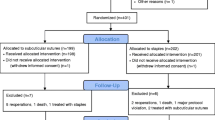Abstract
Purpose
To compare the superficial incisional surgical site infection (SSI) rate after cesarean section (CS) in obese women using subcuticular versus interrupted skin suturing.
Methods
The current randomized controlled clinical trial was conducted at Ain Shams University Maternity Hospital. Obese non-diabetic women who underwent elective CS were randomized into two groups: group I included women who had their skin closed with interrupted mattress suture using non-absorbable polypropylene, and group II included women who had their skin closed with subcuticular suture using the same suture material. Primary outcome measure was superficial incisional SSI and secondary outcome measures were skin closure time, postoperative pain assessed by ten-point visual analog scale (VAS) and short-term cosmetic wound outcome according to the Stony Brook Scar Evaluation Scale (SBSES).
Results
A total of 130 obese women were finally analyzed. Group II (n = 67) was associated with higher incidence of superficial incisional SSI. There were nine cases (13.4 %) compared to three cases (4.8 %) in group I (n = 63); however, this difference was statistically not significant (P = 0.088). Skin closure time was significantly prolonged in group I (8.6 ± 2.3 min versus 5.7 ± 2.2 min, respectively, P < 0.001). Postoperative pain was significantly lower in group I and the mean VAS in group I was 4.7 ± 2 versus 5.5 ± 1.8 in group II (P = 0.017). Using SBSES, group II had mean score 4.5 ± 0.7, while group I had mean score 2.7 ± 1.1. This was statistically significant (P < 0.001), which means a better cosmetic outcome in group II.
Conclusion
Subcuticular skin closure during CS for non-diabetic obese women was significantly associated with better short-term cosmetic outcome, less skin closure time, yet, with slightly higher risk of superficial incisional SSI and significantly more postoperative pain.

Similar content being viewed by others
Abbreviations
- BMI:
-
Body mass index
- CS:
-
Cesarean section
- SBSES:
-
Stony Brook Scar Evaluation Scale
- SSI:
-
Surgical site infection
- VAS:
-
Visual analog scale
References
Berghella V, Baxter JK, Chauhan SP (2005) Evidence-based surgery for cesarean delivery. Am J Obstet Gynecol 193:1607–1617
Tuuli MG, Rampersad RM, Carbone JF, Stamilio D, Macones GA, Odibo AO (2011) Staples compared with subcuticular suture for skin closure after cesarean delivery. A systematic review and meta-analysis. Obstet Gynecol 117:682
Vermillion ST, Lamoutte C, Soper DE, Verdeja A (2000) Wound infection after cesarean. Effect of subcutaneous tissue thickness. Obstet Gynecol 95(6):26–29
Tully L, Gates S, Brocklehurst P, McKenzie-McHarg K, Ayers S (2002) Surgical techniques used during caesarean section operations: results of a national survey of practice in the UK. Eur J Obstet Gynecol Reprod Biol 102:120–126
Galal I, El-Hindawy K (2011) Impact of using triclosan-antibacterial sutures on incidence of surgical site infection. Am J Surg Aug 202(2):133–138
Lucas DN, Yentis SM, Kinsella SM et al (2000) Urgency of caesarean section: a new classification. J R Soc Med 93:346–350
Chelmow D, Rodriguez EJ, Sabatini MM (2004) Suture closure of subcutaneous fat and wound disruption after cesarean delivery: a meta-analysis. Obstet Gynecol 103(5 Pt 1):974–980
Horan TC, Andrus M, Dudeck MA (2008) CDC/NHSN surveillance definition of health care-associated infection and criteria for specific types of infections in the acute care setting. AJIC 36:313–314
Fearmonti R, Bond J, Erdmann D, Levinson H (2010) A review of scar scales and scar measuring devices. Eplasty 10:e43
Leth RA, Uldbjerg N, Nørgaard M, Møller JK, Thomsen RW (2011) Obesity, diabetes, and the risk of infections diagnosed in hospital and post-discharge infections after cesarean section: a prospective cohort study. Acta Obstet Gynecol Scand 90(5):501–509
Altman AD, Allen VM, McNeil SA, Dempster J (2009) Pfannenstiel incision closure: a review of current skin closure techniques. JOGC 31:514–520
Clay FS, Walsh CA, Walsh SR (2011) Staples versus subcuticular sutures for skin closure at cesarean delivery: a meta-analysis of randomized controlled trials. Am J Obstet Gynecol 204:378–383
McLean NR, Fyfe AH, Flint EF, Irvine BH, Calvert MH (1980) Comparison of skin closure using continuous and interrupted nylon sutures. Br J Surg 67:633–635
Onwuanyi ON, Evbuomwan I (1990) Skin closure during appendectomy: a controlled clinical trial of subcuticular and interrupted transdermal suture techniques. J R Coll Surg Edinb 35:353–355
Frishman GN, Schwartz T, Hogan JW (1997) Closure of Pfannenstiel skin incisions. Staples versus subcuticular suture. J Reprod Med 42:627–630
Rousseau JA, Girard K, Turcot-Lemay L, Thomas N (2009) A randomized study comparing skin closure in cesarean sections: staples vs subcuticular sutures. Am J Obstet Gynecol Mar 200(3):265e1–265e4
Cromi A, Ghezzi F, Gottardi A, Cherubino M, Uccella S, Valdatta L (2010) Cosmetic outcomes of various skin closure methods following cesarean delivery: a randomized trial. Am J Obstet Gynecol 203:285
Conflict of interest
The authors reported no conflict of interest. All of the authors had substantial contributions to conception, design, acquisition, analysis and interpretation of data. The research was funded by the authors.
Author information
Authors and Affiliations
Corresponding author
Additional information
Trial registration: Clinical Trials.gov, NCT01713751.
Rights and permissions
About this article
Cite this article
Ibrahim, M.I., Moustafa, G.F., Al-Hamid, A.S.A. et al. Superficial incisional surgical site infection rate after cesarean section in obese women: a randomized controlled trial of subcuticular versus interrupted skin suturing. Arch Gynecol Obstet 289, 981–986 (2014). https://doi.org/10.1007/s00404-013-3098-z
Received:
Accepted:
Published:
Issue Date:
DOI: https://doi.org/10.1007/s00404-013-3098-z




